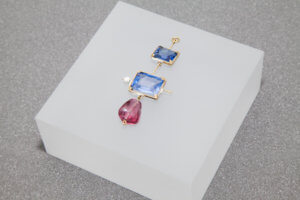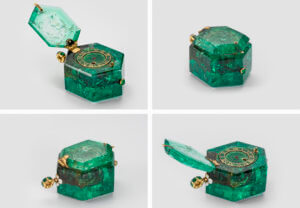Buried Treasure
107 years ago, this month, on 18th June 1912, one of the most remarkable discoveries ever made was unearthed in London. 1912 was the wettest year on record. Workmen were clearing a site at 30/32 Cheapside, close to St. Paul’s Cathedral. As they worked away in the mud and rubble, their picks hit upon a small chest buried below what had been a 17th century building.
You can imagine the workmen downing tools and crowding round to open it up. No one could have been prepared for the surprise hidden within. As they lifted the lid to view the contents, they were amazed to see the gleaming of gold and a sparkling of beautiful gems which had not seen the light of day for at least two and a half centuries. There were over 400 items of gems and jewellery.
The ‘Cheapside Hoard’ as it became known contained both finished and unfinished jewels, loose stones and precious metal. These are believed to be the stock in trade of a working goldsmith or possibly a customer’s items that had been left for safe keeping. What they had discovered was in fact a time capsule.
Nobody knows just when the hoard was buried but it is believed to be in the first half of the 17th century. Nobody knows who buried it and nobody knows why it was buried although there are some theories.
Most of the hoard was acquired by a well know antique dealer of his day known to the navies as ‘Stony Jack’ Lawrence. Although no doubt earning a profit, he helped the Museum of London to seek out any artifacts that might be unearthed on building sites throughout the City.
In 1600, London was more or less contained within the original city walls. Smithfield was outside the city and there were just a few houses strung out between the separate cities of London and Westminster. Hatton Garden was still a garden on the edge of the countryside.
Cheapside in 1600 was the major shopping thoroughfare for the City of London. The site where the discovery was made had been owned by the Worshipful Company of Goldsmiths, whose Hall is just around the corner in Foster Lane. Cheapside was the Bond Street of its day. In 16th century you had to be a Freeman of the City of London and have served a seven-year apprenticeship to sell your wares within the City.
One of the most striking features of the hoard is the variety and quality of the gem stones; emeralds from Colombia, golden beryl from Brazil, sapphires, moonstones and spinels from Sri Lanka, rubies, diamonds and garnets from India, lapis and turquoise from Afghanistan, malachite from Russia, and much more.

There were no hallmarks on any of the items to give a clue to their age, even though hallmarking had been established in 1300. However, among the ancient gems, there were two items which give some indication of when the hoard might have been buried: One is a watch with the maker’s name inscribed – G Ferlite. His best work was done around 1610. The other item, which is even better, is a carnelian seal engraved with a heraldic badge. This was evidence that the hoard was buried after 1640/1.

The trade was not immune to the suffering caused by the civil war of 1642 to 1651 or the plague of 1665 when many of London’s goldsmiths died. The final blow to trade in the City of London was the great fire in 1666.
Was the hoard buried to protect it while the owner went off to fight in the war? – was he lost in battle and his secret with him? Did the owner escape from London during the plague never to return? Or, perhaps like the famous Parmesan cheese of Samuel Pepys, was the hoard buried to protect it from the fire? We will never know. For over 250 years the cellar at 30/32 Cheapside kept its secret. Although the hoard has been recovered, the mystery remains.
When the Museum of London moves to its new location at Smithfield in 2022, there will be a special display of the Cheapside Hoard.